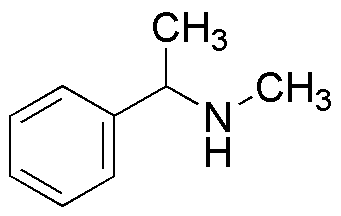Methyl(1-phenylethyl)amine is widely utilized in research focused on:
- Pharmaceutical Development: This compound serves as a building block in the synthesis of various pharmaceuticals, particularly in the development of drugs targeting neurological disorders.
- Organic Synthesis: It is used in organic chemistry as a reagent for creating complex molecules, enhancing the efficiency of chemical reactions compared to traditional methods.
- Polymer Chemistry: Methyl(1-phenylethyl)amine is incorporated into polymer formulations to improve properties such as flexibility and strength, making it valuable in the production of durable materials.
- Flavor and Fragrance Industry: This chemical is utilized in the formulation of flavors and fragrances, providing unique aromatic profiles that enhance consumer products.
- Analytical Chemistry: It acts as a standard in analytical methods, aiding researchers in the quantification and identification of other compounds in complex mixtures.
General Information
Properties
Safety and Regulations
Applications
Methyl(1-phenylethyl)amine is widely utilized in research focused on:
- Pharmaceutical Development: This compound serves as a building block in the synthesis of various pharmaceuticals, particularly in the development of drugs targeting neurological disorders.
- Organic Synthesis: It is used in organic chemistry as a reagent for creating complex molecules, enhancing the efficiency of chemical reactions compared to traditional methods.
- Polymer Chemistry: Methyl(1-phenylethyl)amine is incorporated into polymer formulations to improve properties such as flexibility and strength, making it valuable in the production of durable materials.
- Flavor and Fragrance Industry: This chemical is utilized in the formulation of flavors and fragrances, providing unique aromatic profiles that enhance consumer products.
- Analytical Chemistry: It acts as a standard in analytical methods, aiding researchers in the quantification and identification of other compounds in complex mixtures.
Documents
Safety Data Sheets (SDS)
The SDS provides comprehensive safety information on handling, storage, and disposal of the product.
Product Specification (PS)
The PS provides a comprehensive breakdown of the product’s properties, including chemical composition, physical state, purity, and storage requirements. It also details acceptable quality ranges and the product's intended applications.
Certificates of Analysis (COA)
Search for Certificates of Analysis (COA) by entering the products Lot Number. Lot and Batch Numbers can be found on a product’s label following the words ‘Lot’ or ‘Batch’.
*Catalog Number
*Lot Number
Certificates Of Origin (COO)
This COO confirms the country where the product was manufactured, and also details the materials and components used in it and whether it is derived from natural, synthetic, or other specific sources. This certificate may be required for customs, trade, and regulatory compliance.
*Catalog Number
*Lot Number
Safety Data Sheets (SDS)
The SDS provides comprehensive safety information on handling, storage, and disposal of the product.
DownloadProduct Specification (PS)
The PS provides a comprehensive breakdown of the product’s properties, including chemical composition, physical state, purity, and storage requirements. It also details acceptable quality ranges and the product's intended applications.
DownloadCertificates of Analysis (COA)
Search for Certificates of Analysis (COA) by entering the products Lot Number. Lot and Batch Numbers can be found on a product’s label following the words ‘Lot’ or ‘Batch’.
*Catalog Number
*Lot Number
Certificates Of Origin (COO)
This COO confirms the country where the product was manufactured, and also details the materials and components used in it and whether it is derived from natural, synthetic, or other specific sources. This certificate may be required for customs, trade, and regulatory compliance.


